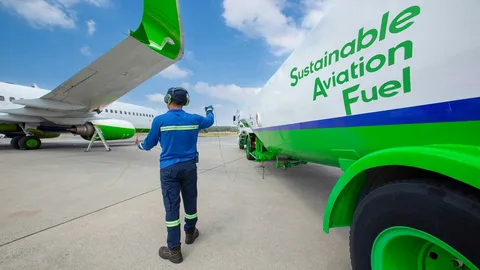The Future of Green Aviation in Asia Pacific

Introduction
The aviation industry in the Asia Pacific region is witnessing rapid growth, driven by increasing air passenger traffic, expanding tourism, and strong economic development. However, this growth also brings an urgent challenge — reducing carbon emissions from aviation. Sustainable Aviation Fuels (SAF) have emerged as one of the most effective solutions to decarbonize the sector without compromising operational efficiency. These fuels, derived from renewable resources such as used cooking oil, agricultural residues, and municipal waste, can reduce lifecycle greenhouse gas emissions by up to 80% compared to conventional jet fuels. The Asia Pacific Sustainable Aviation Fuels Market is experiencing strong momentum, supported by regional governments, airline commitments, and international sustainability mandates.
Market Drivers
One of the primary drivers for the Asia Pacific SAF market is the region’s commitment to achieving net-zero carbon emissions in aviation by 2050. Countries such as Japan, Singapore, and Australia have launched national roadmaps to promote sustainable fuel adoption. For instance, Singapore’s Civil Aviation Authority and Temasek Holdings have jointly launched SAF pilot programs at Changi Airport, setting a precedent for other nations. Additionally, airlines like Qantas, All Nippon Airways (ANA), and Japan Airlines (JAL) are actively entering long-term agreements with SAF producers to secure supply and stabilize prices.
The rising price of conventional jet fuels, combined with increasing carbon taxes and emission penalties, is further accelerating the shift toward SAF. Technological advancements in feedstock processing and refining are also enhancing fuel yields and making production more cost-effective. The growing number of partnerships between biofuel producers, refineries, and airlines is creating a robust regional supply chain.
Market Challenges
Despite the optimistic outlook, the Asia Pacific SAF market faces several challenges. The most significant barrier is high production cost — SAF currently costs two to five times more than traditional jet fuel. This price gap limits mass adoption, especially for low-cost carriers that operate on thin margins. Additionally, the limited availability of sustainable feedstocks and refining infrastructure restricts large-scale production.
Regulatory inconsistencies across the region pose another challenge. While countries like Japan and Singapore have advanced policies for SAF blending, other nations lack clear mandates or financial incentives for producers. Logistics and distribution infrastructure also remain underdeveloped, particularly in emerging markets like India and Indonesia. To achieve meaningful scale, the region will require harmonized policies, cross-border collaborations, and significant investment in R&D and supply chain development.
Market Opportunities
The Asia Pacific region holds immense potential for SAF expansion, primarily due to its abundant biomass resources and growing aviation network. Feedstocks such as palm residues, agricultural waste, and algae offer promising opportunities for cost-efficient fuel production. Emerging economies including India, Indonesia, and Thailand can play pivotal roles by leveraging their agricultural output to build domestic SAF industries.
Investments in refining technologies such as Fischer–Tropsch synthesis and Alcohol-to-Jet (ATJ) pathways are also opening doors for efficient fuel conversion processes. Government initiatives like Australia’s Jet Zero Council and Japan’s Green Innovation Fund are expected to accelerate technology deployment and encourage private sector participation. Furthermore, airports in Singapore, Tokyo, and Sydney are exploring SAF blending facilities, signaling a regional shift toward sustainable fuel ecosystems. The upcoming 2030 carbon reduction targets will likely drive more airlines to enter SAF procurement agreements and co-invest in production facilities.
Regional Insights
The Asia Pacific region presents a diverse landscape for the SAF market. Japan and Singapore are leading with structured policy frameworks and technological investments. Japan aims for a 10% SAF blending target by 2030, supported by partnerships with global producers such as Neste and World Energy. Singapore is positioning itself as a regional SAF hub through its strategic aviation infrastructure and innovation-friendly regulatory environment.
Australia is emerging as another significant player, leveraging its vast agricultural base and renewable energy initiatives to produce feedstocks at scale. Meanwhile, India and Indonesia are in the early stages but possess tremendous long-term potential due to their large feedstock availability and expanding aviation markets. Regional airlines such as Air India, Singapore Airlines, and Qantas are among the early adopters, integrating SAF into their decarbonization roadmaps and public sustainability reporting.
Future Outlook
The Asia Pacific Sustainable Aviation Fuels Market is expected to grow at a compound annual growth rate (CAGR) of more than 40% between 2025 and 2035. As governments strengthen climate commitments and airlines prioritize carbon-neutral operations, SAF will become a mainstream fuel alternative. The entry of new players, joint ventures, and public–private partnerships will enhance local production capacity and lower costs through economies of scale.
The future will also see the emergence of carbon credit trading linked to SAF usage, offering additional financial incentives for airlines. Digital tracking systems ensuring traceability and sustainability certification will become integral to market operations. Over the next decade, regional cooperation and technological innovation will shape Asia Pacific into one of the fastest-growing hubs for sustainable aviation fuel production and adoption.
Conclusion
The Asia Pacific Sustainable Aviation Fuels Market represents a critical step toward achieving a net-zero future for aviation. While the path to affordability and large-scale adoption remains challenging, strategic government support, industry collaboration, and continued R&D investment will bridge existing gaps. As more airports and airlines embrace SAF integration, the region will set global benchmarks in clean aviation. The journey toward sustainable skies has begun — and Asia Pacific is poised to lead this transformation.
- Art
- Crafts
- Dance
- Wellness
- Movie & Television
- Adult Entertainment
- Fitness
- Food
- Jogos
- Gardening
- Health
- Início
- Literature
- Music
- Business & Finance
- Religion
- Shopping
- Sports
- Theater
- Drinks
- Outro



